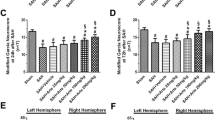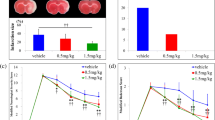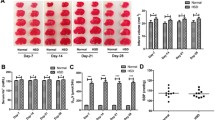Abstract
Sphingosine 1-phosphate (S1P) is a major bioactive lipid mediator in the vascular and immune system. Here, we have shown that inhibition of S1P signaling prevents blood–brain barrier (BBB) dysfunction after ischemia both in vitro and in vivo. In the in vitro BBB models, oxygen-glucose deprivation and reoxygenation (OGD/R) enhanced the expression of an S1P synthesizing enzyme (Sphk1) and S1P transporters (Abca1, Spns2), increasing S1P in culture media. Inhibitors of Sphk1 (SKI-II) or Abca1 (probucol) attenuated the decrease in transendothelial electrical resistance and the increase in permeability caused by OGD/R. In the middle cerebral artery occlusion and reperfusion (MCAO/R) model of mice, probucol administration after MCAO operation reduced the infarction area and vascular leakage, preserving the integrity of tight junction proteins. Furthermore, MCAO/R caused activation of STAT3, a downstream mediator of S1P signaling, which was suppressed by postoperative probucol administration. Accordingly, S1P activated STAT3, both in cultured vascular endothelial cells and pericytes, and STAT3 signaling inhibitor (Stattic) protected BBB dysfunction in OGD/R-treated in vitro BBB models. These results suggest that inhibition of S1P signaling is a strategy to treat BBB impairment after cerebral ischemia and highlight the potential alternative use of probucol, a classical anti-hyperlipidemic drug, for emergency treatment of stroke.






Similar content being viewed by others
References
Abbott NJ, Patabendige AA, Dolman DE, Yusof SR, Begley DJ (2010) Structure and function of the blood-brain barrier. Neurobiol Dis 37(1):13–25. https://doi.org/10.1016/j.nbd.2009.07.030
McConnell HL, Kersch CN, Woltjer RL, Neuwelt EA (2017) The translational significance of the neurovascular unit. J Biol Chem 292(3):762–770. https://doi.org/10.1074/jbc.R116.760215
Zhao Z, Nelson AR, Betsholtz C, Zlokovic BV (2015) Establishment and dysfunction of the blood-brain barrier. Cell 163(5):1064–1078. https://doi.org/10.1016/j.cell.2015.10.067
Liebner S, Dijkhuizen RM, Reiss Y, Plate KH, Agalliu D, Constantin G (2018) Functional morphology of the blood-brain barrier in health and disease. Acta Neuropathol 135(3):311–336. https://doi.org/10.1007/s00401-018-1815-1
Wevers NR, de Vries HE (2016) Morphogens and blood-brain barrier function in health and disease. Tissue Barriers 4(1):e1090524. https://doi.org/10.1080/21688370.2015.1090524
Abdullahi W, Tripathi D, Ronaldson PT (2018) Blood-brain barrier dysfunction in ischemic stroke: targeting tight junctions and transporters for vascular protection. Am J Physiol Cell Physiol 315(3):C343–C356. https://doi.org/10.1152/ajpcell.00095.2018
Jiang X, Andjelkovic AV, Zhu L, Yang T, Bennett MVL, Chen J, Keep RF, Shi Y (2018) Blood-brain barrier dysfunction and recovery after ischemic stroke. Prog Neurobiol 163-164:144–171. https://doi.org/10.1016/j.pneurobio.2017.10.001
Blaho VA, Hla T (2014) An update on the biology of sphingosine 1-phosphate receptors. J Lipid Res 55(8):1596–1608. https://doi.org/10.1194/jlr.R046300
Hannun YA, Obeid LM (2008) Principles of bioactive lipid signalling: lessons from sphingolipids. Nat Rev Mol Cell Biol 9(2):139–150. https://doi.org/10.1038/nrm2329
Nishi T, Kobayashi N, Hisano Y, Kawahara A, Yamaguchi A (2014) Molecular and physiological functions of sphingosine 1-phosphate transporters. Biochim Biophys Acta 1841(5):759–765. https://doi.org/10.1016/j.bbalip.2013.07.012
Vu TM, Ishizu AN, Foo JC, Toh XR, Zhang F, Whee DM, Torta F, Cazenave-Gassiot A et al (2017) Mfsd2b is essential for the sphingosine-1-phosphate export in erythrocytes and platelets. Nature 550(7677):524–528. https://doi.org/10.1038/nature24053
Kono M, Mi Y, Liu Y, Sasaki T, Allende ML, Wu YP, Yamashita T, Proia RL (2004) The sphingosine-1-phosphate receptors S1P1, S1P2, and S1P3 function coordinately during embryonic angiogenesis. J Biol Chem 279(28):29367–29373. https://doi.org/10.1074/jbc.M403937200
Mizugishi K, Yamashita T, Olivera A, Miller GF, Spiegel S, Proia RL (2005) Essential role for sphingosine kinases in neural and vascular development. Mol Cell Biol 25(24):11113–11121. https://doi.org/10.1128/MCB.25.24.11113-11121.2005
Garcia JG, Liu F, Verin AD, Birukova A, Dechert MA, Gerthoffer WT, Bamberg JR, English D (2001) Sphingosine 1-phosphate promotes endothelial cell barrier integrity by Edg-dependent cytoskeletal rearrangement. J Clin Invest 108(5):689–701. https://doi.org/10.1172/JCI12450
Wiltshire R, Nelson V, Kho DT, Angel CE, O’Carroll SJ, Graham ES (2016) Regulation of human cerebro-microvascular endothelial baso-lateral adhesion and barrier function by S1P through dual involvement of S1P1 and S1P2 receptors. Sci Rep 6:19814–19813. https://doi.org/10.1038/srep19814
Egom EE, Mamas MA, Chacko S, Stringer SE, Charlton-Menys V, El-Omar M, Chirico D, Clarke B et al (2013) Serum sphingolipids level as a novel potential marker for early detection of human myocardial ischaemic injury. Front Physiol 4:130. https://doi.org/10.3389/fphys.2013.00130
Salas-Perdomo A, Miro-Mur F, Gallizioli M, Brait VH, Justicia C, Meissner A, Urra X, Chamorro A et al (2019) Role of the S1P pathway and inhibition by fingolimod in preventing hemorrhagic transformation after stroke. Sci Rep 9(1):8309. https://doi.org/10.1038/s41598-019-44845-5
Shi Y, Rehman H, Ramshesh VK, Schwartz J, Liu Q, Krishnasamy Y, Zhang X, Lemasters JJ et al (2012) Sphingosine kinase-2 inhibition improves mitochondrial function and survival after hepatic ischemia-reperfusion. J Hepatol 56(1):137–145. https://doi.org/10.1016/j.jhep.2011.05.025
Li W, Xu H, Testai FD (2016) Mechanism of action and clinical potential of fingolimod for the treatment of stroke. Front Neurol 7:139. https://doi.org/10.3389/fneur.2016.00139
Sun N, Keep RF, Hua Y, Xi G (2016) Critical role of the sphingolipid pathway in stroke: a review of current utility and potential therapeutic targets. Transl Stroke Res 7(5):420–438. https://doi.org/10.1007/s12975-016-0477-3
Nakagawa S, Deli MA, Kawaguchi H, Shimizudani T, Shimono T, Kittel A, Tanaka K, Niwa M (2009) A new blood-brain barrier model using primary rat brain endothelial cells, pericytes and astrocytes. Neurochem Int 54(3–4):253–263. https://doi.org/10.1016/j.neuint.2008.12.002
Nakagawa S, Deli MA, Nakao S, Honda M, Hayashi K, Nakaoke R, Kataoka Y, Niwa M (2007) Pericytes from brain microvessels strengthen the barrier integrity in primary cultures of rat brain endothelial cells. Cell Mol Neurobiol 27(6):687–694. https://doi.org/10.1007/s10571-007-9195-4
Takeshita T, Nakagawa S, Tatsumi R, So G, Hayashi K, Tanaka K, Deli MA, Nagata I et al (2014) Cilostazol attenuates ischemia-reperfusion-induced blood-brain barrier dysfunction enhanced by advanced glycation endproducts via transforming growth factor-beta1 signaling. Mol Cell Neurosci 60:1–9. https://doi.org/10.1016/j.mcn.2014.01.006
Rousselet E, Kriz J, Seidah NG (2012) Mouse model of intraluminal MCAO: cerebral infarct evaluation by cresyl violet staining. J Vis Exp 69. https://doi.org/10.3791/4038
Chen L, Swartz KR, Toborek M (2009) Vessel microport technique for applications in cerebrovascular research. J Neurosci Res 87(7):1718–1727. https://doi.org/10.1002/jnr.21973
Hawkins BT, Abbruscato TJ, Egleton RD, Brown RC, Huber JD, Campos CR, Davis TP (2004) Nicotine increases in vivo blood-brain barrier permeability and alters cerebral microvascular tight junction protein distribution. Brain Res 1027(1–2):48–58. https://doi.org/10.1016/j.brainres.2004.08.043
Sakakibara A, Furuse M, Saitou M, Ando-Akatsuka Y, Tsukita S (1997) Possible involvement of phosphorylation of occludin in tight junction formation. J Cell Biol 137(6):1393–1401. https://doi.org/10.1083/jcb.137.6.1393
Kobayashi K, Oyama S, Numata A, Rahman MM, Kumura H (2013) Lipopolysaccharide disrupts the milk-blood barrier by modulating claudins in mammary alveolar tight junctions. PLoS One 8(4):e62187. https://doi.org/10.1371/journal.pone.0062187
Liang J, Nagahashi M, Kim EY, Harikumar KB, Yamada A, Huang WC, Hait NC, Allegood JC et al (2013) Sphingosine-1-phosphate links persistent STAT3 activation, chronic intestinal inflammation, and development of colitis-associated cancer. Cancer Cell 23(1):107–120. https://doi.org/10.1016/j.ccr.2012.11.013
Choi JS, Kim SY, Cha JH, Choi YS, Sung KW, Oh ST, Kim ON, Chung JW et al (2003) Upregulation of gp130 and STAT3 activation in the rat hippocampus following transient forebrain ischemia. Glia 41(3):237–246. https://doi.org/10.1002/glia.10186
Satriotomo I, Bowen KK, Vemuganti R (2006) JAK2 and STAT3 activation contributes to neuronal damage following transient focal cerebral ischemia. J Neurochem 98(5):1353–1368. https://doi.org/10.1111/j.1471-4159.2006.04051.x
Suzuki S, Tanaka K, Nogawa S, Dembo T, Kosakai A, Fukuuchi Y (2001) Phosphorylation of signal transducer and activator of transcription-3 (Stat3) after focal cerebral ischemia in rats. Exp Neurol 170(1):63–71. https://doi.org/10.1006/exnr.2001.7701
Du J, Zeng C, Li Q, Chen B, Liu H, Huang X, Huang Q (2012) LPS and TNF-alpha induce expression of sphingosine-1-phosphate receptor-2 in human microvascular endothelial cells. Pathol Res Pract 208(2):82–88. https://doi.org/10.1016/j.prp.2011.11.008
Prager B, Spampinato SF, Ransohoff RM (2015) Sphingosine 1-phosphate signaling at the blood-brain barrier. Trends Mol Med 21(6):354–363. https://doi.org/10.1016/j.molmed.2015.03.006
Lambertsen KL, Biber K, Finsen B (2012) Inflammatory cytokines in experimental and human stroke. J Cereb Blood Flow Metab 32(9):1677–1698. https://doi.org/10.1038/jcbfm.2012.88
Reeson P, Tennant KA, Gerrow K, Wang J, Weiser Novak S, Thompson K, Lockhart KL, Holmes A et al (2015) Delayed inhibition of VEGF signaling after stroke attenuates blood-brain barrier breakdown and improves functional recovery in a comorbidity-dependent manner. J Neurosci 35(13):5128–5143. https://doi.org/10.1523/JNEUROSCI.2810-14.2015
Yang C, Hawkins KE, Dore S, Candelario-Jalil E (2019) Neuroinflammatory mechanisms of blood-brain barrier damage in ischemic stroke. Am J Physiol Cell Physiol 316(2):C135–C153. https://doi.org/10.1152/ajpcell.00136.2018
Abbott NJ, Ronnback L, Hansson E (2006) Astrocyte-endothelial interactions at the blood-brain barrier. Nat Rev Neurosci 7(1):41–53. https://doi.org/10.1038/nrn1824
Testai FD, Kilkus JP, Berdyshev E, Gorshkova I, Natarajan V, Dawson G (2014) Multiple sphingolipid abnormalities following cerebral microendothelial hypoxia. J Neurochem 131(4):530–540. https://doi.org/10.1111/jnc.12836
Wan Y, Jin HJ, Zhu YY, Fang Z, Mao L, He Q, Xia YP, Li M et al (2018) MicroRNA-149-5p regulates blood-brain barrier permeability after transient middle cerebral artery occlusion in rats by targeting S1PR2 of pericytes. FASEB J 32(6):3133–3148. https://doi.org/10.1096/fj.201701121R
Zheng S, Wei S, Wang X, Xu Y, Xiao Y, Liu H, Jia J, Cheng J (2015) Sphingosine kinase 1 mediates neuroinflammation following cerebral ischemia. Exp Neurol 272:160–169. https://doi.org/10.1016/j.expneurol.2015.03.012
Morizawa YM, Hirayama Y, Ohno N, Shibata S, Shigetomi E, Sui Y, Nabekura J, Sato K et al (2017) Reactive astrocytes function as phagocytes after brain ischemia via ABCA1-mediated pathway. Nat Commun 8(1):28. https://doi.org/10.1038/s41467-017-00037-1
Du Y, Zhang X, Ji H, Liu H, Li S, Li L (2012) Probucol and atorvastatin in combination protect rat brains in MCAO model: upregulating peroxiredoxin2, Foxo3a and Nrf2 expression. Neurosci Lett 509(2):110–115. https://doi.org/10.1016/j.neulet.2011.12.054
Jung YS, Park JH, Kim H, Kim SY, Hwang JY, Hong KW, Bae SS, Choi BT et al (2016) Probucol inhibits LPS-induced microglia activation and ameliorates brain ischemic injury in normal and hyperlipidemic mice. Acta Pharmacol Sin 37(8):1031–1044. https://doi.org/10.1038/aps.2016.51
Kim JH, Park SH, Bae SS, Hong KW, Kim YD, Park KP, Choi BT, Shin HK (2011) Combinatorial effect of probucol and cilostazol in focal ischemic mice with hypercholesterolemia. J Pharmacol Exp Ther 338(2):451–457. https://doi.org/10.1124/jpet.111.181180
Takechi R, Galloway S, Pallebage-Gamarallage MM, Lam V, Dhaliwal SS, Mamo JC (2013) Probucol prevents blood-brain barrier dysfunction in wild-type mice induced by saturated fat or cholesterol feeding. Clin Exp Pharmacol Physiol 40(1):45–52. https://doi.org/10.1111/1440-1681.12032
Mamo JC, Lam V, Brook E, Mooranian A, Al-Salami H, Fimognari N, Nesbit M, Takechi R (2019) Probucol prevents blood-brain barrier dysfunction and cognitive decline in mice maintained on pro-diabetic diet. Diab Vasc Dis Res 16(1):87–97. https://doi.org/10.1177/1479164118795274
Lee H, Deng J, Kujawski M, Yang C, Liu Y, Herrmann A, Kortylewski M, Horne D et al (2010) STAT3-induced S1PR1 expression is crucial for persistent STAT3 activation in tumors. Nat Med 16(12):1421–1428. https://doi.org/10.1038/nm.2250
Maceyka M, Harikumar KB, Milstien S, Spiegel S (2012) Sphingosine-1-phosphate signaling and its role in disease. Trends Cell Biol 22(1):50–60. https://doi.org/10.1016/j.tcb.2011.09.003
Favari E, Zanotti I, Zimetti F, Ronda N, Bernini F, Rothblat GH (2004) Probucol inhibits ABCA1-mediated cellular lipid efflux. Arterioscler Thromb Vasc Biol 24(12):2345–2350. https://doi.org/10.1161/01.ATV.0000148706.15947.8a
Cattelotte J, Andre P, Ouellet M, Bourasset F, Scherrmann JM, Cisternino S (2008) In situ mouse carotid perfusion model: glucose and cholesterol transport in the eye and brain. J Cereb Blood Flow Metab 28(8):1449–1459. https://doi.org/10.1038/jcbfm.2008.34
Yamashita S, Matsuzawa Y (2009) Where are we with probucol: a new life for an old drug? Atherosclerosis 207(1):16–23. https://doi.org/10.1016/j.atherosclerosis.2009.04.002
Singla DK, Kaur K, Sharma AK, Dhingra S, Singal PK (2007) Probucol promotes endogenous antioxidant reserve and confers protection against reperfusion injury. Can J Physiol Pharmacol 85(3–4):439–443. https://doi.org/10.1139/y06-071
Christoffersen C, Federspiel CK, Borup A, Christensen PM, Madsen AN, Heine M, Nielsen CH, Kjaer A et al (2018) The apolipoprotein M/S1P axis controls triglyceride metabolism and brown fat activity. Cell Rep 22(1):175–188. https://doi.org/10.1016/j.celrep.2017.12.029
Yamamoto S, Tanigawa H, Li X, Komaru Y, Billheimer JT, Rader DJ (2011) Pharmacologic suppression of hepatic ATP-binding cassette transporter 1 activity in mice reduces high-density lipoprotein cholesterol levels but promotes reverse cholesterol transport. Circulation 124(12):1382–1390. https://doi.org/10.1161/CIRCULATIONAHA.110.009704
Cui X, Chopp M, Zacharek A, Karasinska JM, Cui Y, Ning R, Zhang Y, Wang Y et al (2015) Deficiency of brain ATP-binding cassette transporter A-1 exacerbates blood-brain barrier and white matter damage after stroke. Stroke 46(3):827–834. https://doi.org/10.1161/STROKEAHA.114.007145
Acknowledgments
We would like to thank Editage (www.editage.com) for English language editing.
Funding
This work was supported by JSPS KAKENHI Grant Numbers 26462167 and 17K10838 from the Japan Society for the Promotion of Science (JSPS).
Author information
Authors and Affiliations
Corresponding author
Ethics declarations
Conflict of Interest
The authors declare that they have no competing interests.
Ethical Approval
Animal care and experimental procedures were performed in accordance with the Guidelines for Animal Experimentation of Nagasaki University with approval of the Institutional Animal Care and Use Committee.
Additional information
Publisher’s Note
Springer Nature remains neutral with regard to jurisdictional claims in published maps and institutional affiliations.
Rights and permissions
About this article
Cite this article
Nakagawa, S., Aruga, J. Sphingosine 1-Phosphate Signaling Is Involved in Impaired Blood–Brain Barrier Function in Ischemia–Reperfusion Injury. Mol Neurobiol 57, 1594–1606 (2020). https://doi.org/10.1007/s12035-019-01844-x
Received:
Accepted:
Published:
Issue Date:
DOI: https://doi.org/10.1007/s12035-019-01844-x




